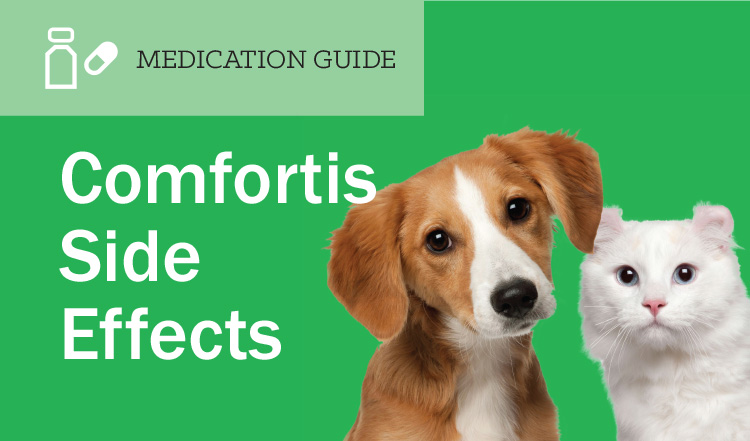
Comfortis Side Effects
It’s surprising that such a tiny insect can pose such a large problem, but fleas can be one of the largest burdens for pets and their owners. These parasites can cause serious discomfort to your furry friend and even facilitate the spread of disease. Unfortunately, fleas can be extremely stubborn and many treatments only eliminate adult stages of fleas. Though this may provide a temporary reprieve from the onslaught of itching, hundreds of flea eggs are likely festering in your pet’s habitat.
Flea eggs hidden in your carpets and in your pet’s bed have to hatch sometime and, when they do, they need to feed on your pet to survive. To completely eradicate fleas from your animal and end the flea life cycle for good, it takes a treatment that provides protection even after these new eggs hatch. Comfortis is one such solution that kills adult fleas on your pet and stays active long past the typical duration of the flea life cycle.
Comfortis works by using the active ingredient spinosad , an insecticide which acts on the nervous system of insects. But what stands out about Comfortis is not that it wipes out all adult fleas on your pet within a 4-hour period, but that it continues to remain effective for a full month and eliminates between 98% and 99.8% of fleas in a household over a three-month treatment period. But as with any product containing insecticides, there are some adverse effects associated with its use.

What Adverse Reactions are Associated with Comfortis?
Comfortis is a prescription strength medication, which means itís not appropriate for just any cat or dog. If your pet is suffering from a flea infestation , talk to your veterinarian about using Comfortis and he should be able to determine if itís appropriate for your animal. Comfortis is available in several formulations to provide accurate dosing for both cats and dogs of varying weights. Using the proper formulation and following your veterinarianís instructions are vital to minimizing adverse reactions.
Side effects of Comfortis are rare, with less than 1% of dogs and cats affected adversely in clinical trials. Both cats and dogs that reacted poorly to the medication experienced vomiting, lethargy, anorexia, weight loss, and diarrhea. Dogs were also subject to coughing, polydipsia, erythema, hyperactivity, excessive salivations and an increased appetite. If your pet experiences these or other symptoms that you believe are caused by Comfortis, talk to your veterinarian about the problem as soon as possible.
As stated, the best way to reduce the chance of adverse reactions to Comfortis is to administer it properly. This is a relatively simple task, since the medication is in the form of a chewable tablet with the proper dose for a certain weight range; however, for pets that are on the outer limits of a given weight range, maintaining this weight during the administration can be crucial to ensuring its efficacy.

Alternative Flea Treatments
A prescription flea treatment isn’t always a viable option. Often, pet owners are too busy to visit the veterinarian. Others may want to simply prevent an infestation before it happens, which may disqualify their pet from needing a prescription flea treatment. For these pet owners and more, over-the-counter topical preventives like Frontline Plus are available to both dogs and cats and both treat existing infestations and prevent those that may occur in the future.
Additionally, pets infested with insects other than fleas may require a stronger treatment. If your dog is infested for ticks, K9 Advantix II offers similar protection against fleas while eliminating ticks. Intestinal parasites spread by fleas and ticks can also require additional treatment, which may be better administered with one medication that treats both flea infestations and internal parasites. This can be accomplished with other prescription medications, such as Revolution.
We hope that this information helps determine which medication is right for your pet. For more information on Comfortis and treating flea infestations, check out the articles below:

